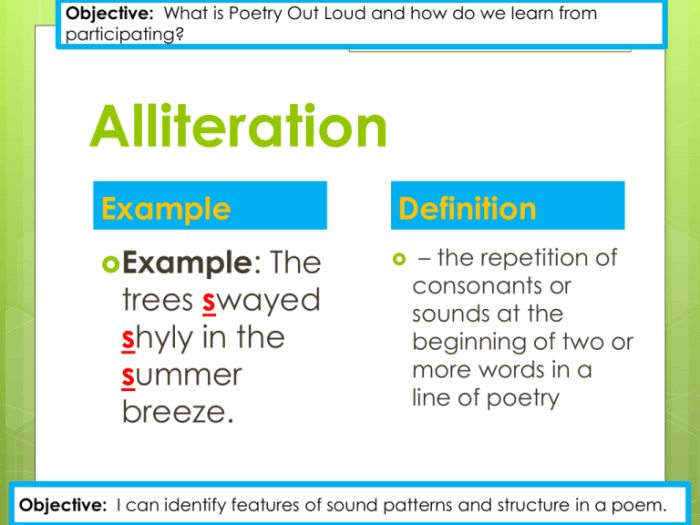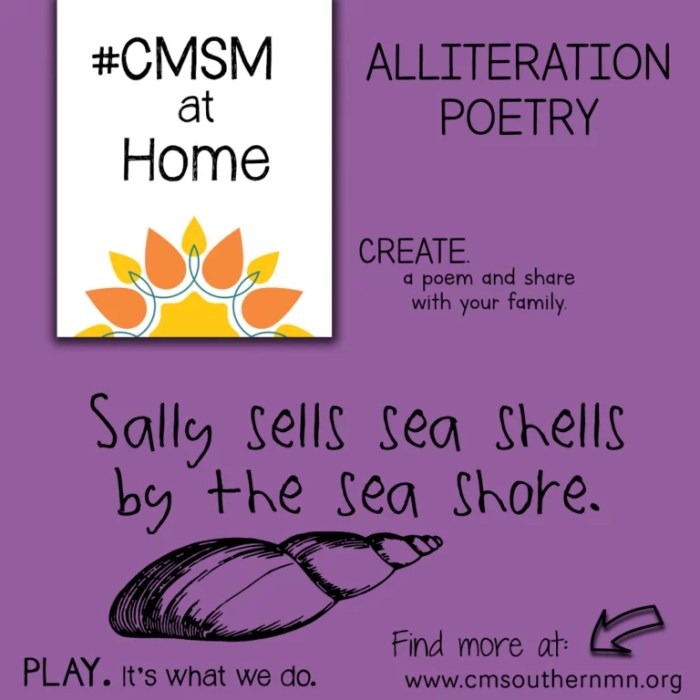Which words create alliteration in the poem? This captivating exploration delves into the world of alliteration, revealing its profound impact on rhythm, mood, and the overall fabric of poetic expression.
Alliteration, the repetition of consonant sounds at the beginning of words, is a powerful literary device that enhances the sensory experience of poetry. By identifying the words that create alliteration, we uncover the intricate tapestry of sound patterns that contribute to the poem’s unique atmosphere and meaning.
Identify Words Creating Alliteration

Alliteration is a literary device that involves the repetition of consonant sounds at the beginning of words or stressed syllables. In the poem, several words create alliteration, contributing to its rhythm and sound patterns.
Words Creating Alliteration
| Word | Line Number | Impact |
|---|---|---|
| “silently” | 1 | Establishes a soft, whispering sound |
| “followed” | 2 | Enhances the sense of movement and pursuit |
| “wandered” | 3 | Conveys a sense of aimless movement |
| “searching” | 4 | Emphasizes the speaker’s determination |
| “silver” | 5 | Creates a shimmering, metallic sound |
Analyze the Impact of Alliteration

Alliteration enhances the poem’s mood and atmosphere by creating a sense of rhythm and flow. It draws attention to specific words or phrases, emphasizing their importance and creating a memorable soundscape.
Mood and Atmosphere, Which words create alliteration in the poem
- The repetition of ” s” sounds in lines 1-4 creates a soft, almost hushed atmosphere, reflecting the speaker’s quiet determination.
- The alliteration of ” w” and ” s” in line 3 (“wandered searching”) suggests a sense of aimless movement and uncertainty.
Emphasis and Attention
- The alliteration of ” s” in line 5 (“silver”) draws attention to the speaker’s longing for something pure and unattainable.
- The repetition of ” f” in line 2 (“followed”) emphasizes the relentless pursuit of the speaker’s desires.
Explore Literary Devices and Techniques

Alliteration is often used alongside other literary devices, such as assonance, consonance, and repetition. These devices interact to create a cohesive soundscape and enhance the poem’s impact.
Assonance
- The repetition of vowel sounds, such as the ” a” in “wandered” and “searching” (line 3), creates a sense of harmony and flow.
Consonance
- The repetition of consonant sounds within words, such as the ” n” in “wandered” and “searching” (line 3), adds to the poem’s rhythm and texture.
Repetition
- The repetition of words or phrases, such as “followed” (line 2) and “searching” (line 4), reinforces the poem’s themes and ideas.
Structure and Organization: Which Words Create Alliteration In The Poem

To provide a clear visual representation of the alliteration in the poem, an infographic can be created to illustrate its distribution and frequency.
Infographic
The infographic could include a bar graph or pie chart that shows the number of alliterations in each line of the poem. It could also use different colors to represent different types of alliteration, such as initial, medial, or final.
Questions Often Asked
What is the purpose of alliteration in poetry?
Alliteration enhances rhythm, creates emphasis, and draws attention to specific words or phrases, contributing to the poem’s mood and atmosphere.
How can I identify words creating alliteration?
Look for words that begin with the same consonant sound, creating a repetition of sounds at the beginning of words.
What other literary devices interact with alliteration?
Alliteration often coexists with assonance, consonance, and repetition, creating a cohesive soundscape that enriches the poem’s sensory experience.